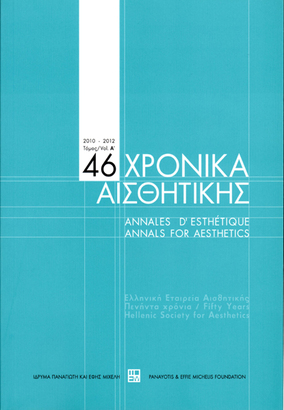Η αισθητική κατηγορία του υψηλού και η νεωτερική θεώρηση του τοπίου
Part of : Χρονικά αισθητικής : ετήσιον δελτίον της Ελληνικής Εταιρείας Αισθητικής ; Vol.46, No.Β, 2010, pages 3-15
Issue:
Pages:
3-15
Parallel Title:
The aesthetic category of sublime and its relation to the modern perception of landscape
Section Title:
Αισθητική του Τοπίου - Αισθητική του Περιβάλλοντος/Landscape Aesthetics - Aesthetics of Environment
Author:
Abstract:
The aesthetic category of Sublime in general, its definition as a concept, as well as the theoretical maturation of this concept, are clearly associated with the end of the 18th and the beginning of the 19th century. That is to say, they are associated with an important historical period through which modern aesthetic theory has gradually been developed.In our investigation the theoretical interest for Sublime emotion is presented as a result of cultural processes which, having transcended the concept of classical beauty, have been oriented toward the romantic appreciation of the totality of the aesthetic experience.In addition, the formation of the aesthetic category of Sublime is presented as the result of two opposing tendencies. On the one hand the effort for rational control persists; the effort for social and cultural organization, or at least the effort for minute analysis and categorization of uncontrolled experience, as expressed for example in Edmund Burke’s Philosophical Enquiry into the Origin of our Ideas of the Sublime and Beautiful. On the other hand an upsetting realization emerges. Aesthetic emotion may by far exceed the influence of the controlling conscience and what is equally disturbing, natural forces may by far exceed human powers. In the above mentioned way, we may accept the concept of Sublime as describing the modern western ambivalence toward the organizing imperatives of the Enlightment. It describes their acceptance, plus the romantic rejection of this organizing insistence.However, through Sublime, one more ambivalent perception of the modern western societies is declared. It concerns Landscape and has also been formatted during the same period at the end of the 18th and the beginning of the 19th century. During this historic era the volition for structural and aesthetic control of Nature and Landscape still declares its cultural priority but, in the same time, a counter type of Landscape evaluation is developed.It concerns the admiration for primordial natural formations, whose expression of power may by far overwhelm human physical dimensions or human social arrogance. The deep cultural relation between the social ethos in general, the specific aesthetic categorization concerning the concept of Sublime in particular, and the Landscape perception, during the end of the 18th and the beginning of the 19th century, comprise the object of our proposed investigation.
Subject:
Subject (LC):
Keywords:
Αναγέννηση, ρομαντισμός, ζωγραφική, τοπία
Notes:
Περιέχει εικόνες




